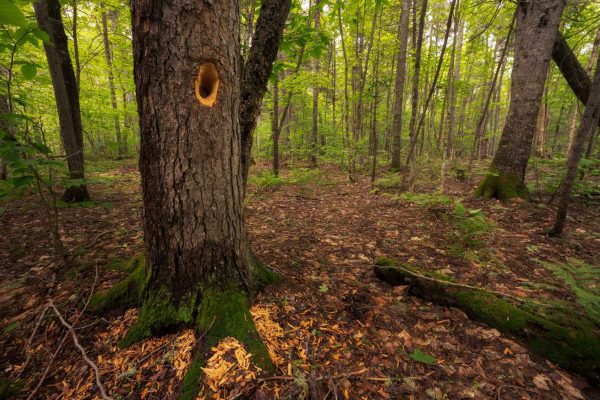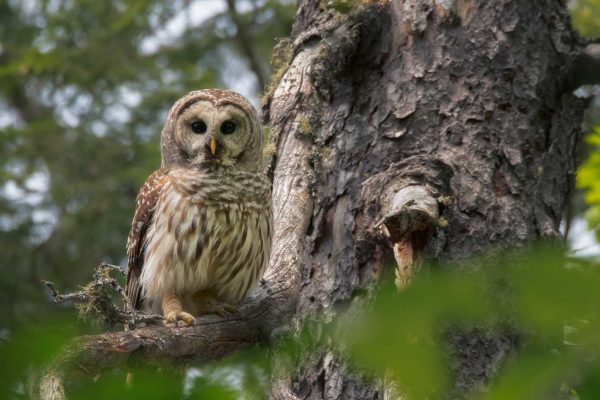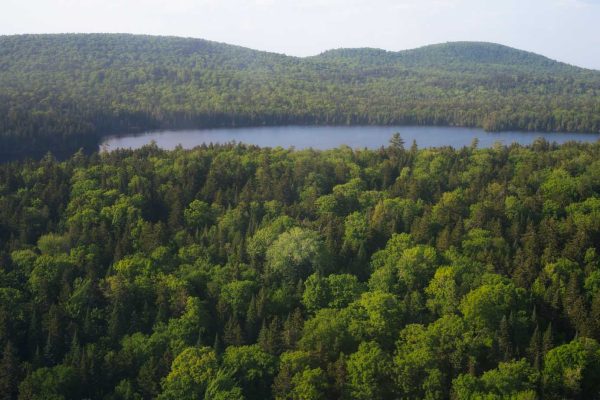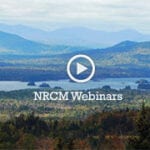Part 2: Big Reed Forest Reserve
In honor of the 50th anniversary of the Endangered Species Act, the Natural Resources Council of Maine is partnering with Maine photographer Nathaniel Child on a blog and photography series to bring awareness to some of Maine’s threatened and endangered species and their habitat. This is part two of Stepping Back in Time in Maine’s North Woods. Currently, a zinc mine is being pursued in the Katahdin region at Pickett Mountain. NRCM has joined with two tribes in Maine, Earthjustice, and the Conservation Law Foundation to oppose the mine because of the damage it would do to the region’s clean waters and fisheries. Read on to learn more about this special region and consider joining the fight to protect it.
From my vantage point floating in the middle of Big Reed Pond in northern Maine, there is nothing to suggest that the forest that fills my field of view is any different from those surrounding Maine’s other pristine wilderness ponds. A few white pine trees can be seen protruding from the surrounding trees, and white cedars along the shore lean out over the water, their trunks gracefully curving up toward the sky. Hiding in plain sight is a forest unlike any in the eastern United States: the Big Reed Forest Reserve, a 5,000-acre virgin old-growth forest that has never been subjected to a logger’s axe.

Moody clouds over old growth forest at Big Reed Pond
In 1820, David Pingree, a wealthy shipping merchant, started buying up vast tracts of land in Maine and began harvesting timber on them. Over the next 150 years, he and his family amassed nearly one million acres of forest land. At first the area that would eventually become Big Reed was passed over due to the lack of white pines, the valuable tree at the time. When the market changed and the demand for spruce spiked, Big Reed was again spared because no streams large enough to drive wood flowed nearby. At some point, the Pingree family realized that they were sitting on a rare piece of uncut forest, and actively began protecting it from logging.

Big Reed Pond viewed from the air
In the 1980s, the Pingree family reached out to The Nature Conservancy to discuss selling the land. After extensive negotiations, land swaps with the State of Maine, and a massive fundraising effort, The Nature Conservancy purchased 3,800 acres of forest. A second purchase of 1,013 acres a few years later brought the entire Big Reed Pond watershed under the protection of The Nature Conservancy. The resulting block of nearly 5,000 acres is the largest contiguous old-growth forest in the eastern United States and contains two-thirds of New England’s total old growth, and three-quarters of Maine’s. The expansion of Maine’s ecological reserve system may also provide opportunities to conserve and study unique lands like this.

Thick undergrowth
As I paddle my canoe toward the tiny wooden dock that’s the only sign of human activity on the entire pond, I try to guess what the forest is like beyond the water’s edge. When I hear the phrase “old-growth forest,” I imagine the towering redwoods of California; the lush, moss-draped rainforests of Tongass National Forest in Alaska; or the immensely old, primordial Fangorn Forest described by J.R.R. Tolkien in The Lord of the Rings. However, as a result of extreme heat and cold, strong winds, storms, and other environmental stresses, trees in the eastern U.S. rarely reach the great age and incredible size of their counterparts in the West. What defines an old-growth forest in the East is a matter of some debate, but in general, the presence of large dead logs more than 16 inches in diameter, pit and mound topography (created by the root balls of large trees that have fallen over), and a forest dominated by climax species like sugar maple, red spruce, white cedar, and white pine are distinctive characteristics of an old forest.
Although Big Reed’s forests aren’t quite as big or as old as those out West, they still boast some pretty impressive statistics. The oldest tree is a red spruce that was measured at 352 years old by a researcher doing a study in the Reserve. There is also a white cedar that was aged at 329 years old, a 314-year-old sugar maple, a yellow birch that is at least 249 years old, and an American hop hornbeam that was 281 at the time of the study. The average tree age in Big Reed is 107 years old, which is older than the oldest trees in many of Maine’s harvested forests.

A pileated woodpecker hole and wood chips
I pull the canoe up onto the shore, swing my camera pack onto my shoulders, and face the trees. Igor Sikorsky III, the owner of the nearby Bradford Camps and pilot of the floatplane that dropped me off at the pond, had pointed out an elm tree with a five-foot-diameter trunk on the flight in, and I was excited to try and find it. Navigating in Big Reed is not for the faint of heart: there is only one trail, a small path used by fishermen to access the pond from a nearby logging road. Getting anywhere else within the Reserve requires bushwhacking through a forest where downed logs are everywhere, frequently stacked two or three high. Armed with a compass, a rough map with a hand-drawn dot labeled “Elm Tree,” and a tip to “follow the line of the dock through the trees,” I set off in search of the massive elm.
As I enter the forest, I get my first look at eastern old growth. The first thing that jumps out at me is not so much the overall size of the trees, but the diversity of tree sizes. Unlike the Redwoods, where there seem to be huge trees everywhere you look, I’m greeted by everything from a carpet of tiny saplings to trees 24 inches or more in diameter. Thick groves of young trees congregate under the areas with thinner canopies, where the death of an old tree opened a hole in the canopy, allowing more light to reach the forest floor. Here and there, the largest “mother trees” reach up to the canopy, their gnarled and twisted branches hinting at the storms they’ve weathered over the centuries.

A large tree with buttressed roots next to the trail
It doesn’t take me long to get sidetracked from my quest for the elm. A high-pitched bird call alerts me to the presence of a small flock of Blackburnian Warblers, a small warbler with a fiery orange throat that is stubbornly uncooperative every time I try to photograph them. They flit through the trees over a small, rocky rise that reminds me of the hill where the hobbits Merry and Pippin first meet the Ent Treebeard in The Lord of the Rings. I try to get a photo, but they continue to hold on to their status as one of my nemesis birds as they remain frustratingly just out of sight high in the canopy. A short time later, a single “whooooo” echoing through the woods leads me to a Barred Owl gazing curiously at me from its perch high in a dead tree.

Barred Owl
The forest floor has plenty of distractions as well. Bunchberries, star flowers, blue-bead lilies, a red net-winged beetle, and a diurnal firefly all catch my eye as I make my way between trees. I’m thoroughly off of my original bearing now, but I can’t resist wandering around and checking out these residents of Big Reed. Mosses and ferns are plentiful, especially on the rocks that jut out of the leaf litter. After meandering through the woods for a while, I catch a glimpse of a massive tree through the dense trunks. Despite my meandering path, I’ve finally made it to the elm tree.

Diurnal firefly
Elm trees were once a common member of Maine’s forest until Dutch Elm Disease arrived in the mid 1900s. A huge number of elms were wiped out by the fungus, which is carried from tree to tree by elm bark beetles. Whether the Big Reed elm is one of the few naturally resistant elms or it was just too far away from other elms for the beetles to find, I have no way of knowing. But as I lean against its trunk, feeling dwarfed by the sheer size of it, I’m thankful that this amazing specimen has survived.

The giant elm
One tree in Big Reed that hasn’t escaped the influence of humans is the American beech. The understory is littered with small beech trees, their normally smooth bark distorted and split by beech bark disease. Before beech bark disease was brought to the U.S. from Europe in the 1920s, beech would have been a prominent canopy tree in the preserve. Now, nearly all the beeches are small and blistered, doomed to die before they’re old enough to produce the beech nuts that feed so many of the forest’s animals.

An American beech with beech bark disease
I could easily spend days wandering through these woods, admiring the gnarled matriarchs that rule the canopy. But I have a plane to catch, so I reluctantly turn away from the elm to make my way back toward the pond. Bird calls continue to echo from the treetops, and I can make out the songs of a Red-eyed Vireo and a Northern Parula. I find another group of Blackburnian Warblers, and after a few minutes of searching, catch a brief glimpse of one perched on an open branch. The warbler pauses for a moment, lets out a brief song, then flies off in pursuit of an insect, but not before I’m able to bring my camera up to my eye and fire off a few frames. Finally, I have succeeded in photographing this charismatic little bird. I resume the trek back to the dock, my mood buoyed by the experience with the warbler.

Blackburnian Warbler
After passing through a mossy grove of red spruce and a field of moss- and flower-covered boulders, I’m back at the dock watching the floatplane as it taxis toward me. A few short hours is nowhere near enough time to fully experience a forest like Big Reed, so I vow to make a return trip to uncover more of Big Reed’s secrets. A couple of minutes later, my gear is loaded and we’re in the air. I can just make out the distinctive foliage of the giant elm gleaming in the late afternoon light as we fly away from the pond.

The giant elm and Big Reed Pond from the air
Less than a week later, I find myself heading back to Big Reed. This time I take the long way in, driving 40 miles on gravel logging roads where massive logging trucks could be hiding behind any curve or hill. The terrestrial route offers a full tour of a variety of logged forests: stump-littered desolations of fresh clearcuts, dense even-age regenerating plots, and older forests with few remaining visible logging scars all pass by my windows.
But as I walk down the trail toward Big Reed Pond, I’m able to see the boundary between the preserve and the logging land. On one side, the cut stumps of past harvests are visible, surrounded by the young growth that sprang with the sudden abundance of light. On the other, the stumps are broken rather than cut, and every stump has the trunk of a decaying tree next to it, covered in fungi, continuing a cycle of life, death, decay, and rebirth that has been going on undisturbed for millennia.

Flamed Disc land snail
A set of moose prints joins the trail, the huge hoof marks crisp and fresh in the mud from the previous day’s rain. I hear the constant rasping calls of Yellow-bellied Sapsucker nestlings, and look up to see a small cavity in a branch high up on a huge yellow birch. A head pokes out, then suddenly one of the adults jumps out, flying quickly to a neighboring tree. The call of an Ovenbird echoes through the woods, and a Least Flycatcher chirps from the hill to my left. All around, the only sounds I can hear are the same sounds that have echoed through this forest for thousands of years.
I reach the pond, where there is a sign and a pair of canoes left by The Nature Conservancy. A trio of fishermen from Bradford Camps slowly paddle their way around the lake, occasionally casting a line out into the water. I watch dragonflies cruise over the surface of the pond, darting this way and that in pursuit of prey. At my feet, a tiny patch of sundews sits near the edge of the pond, a few of the leaves slowly curling around freshly caught insects, and a green frog lies in wait, half submerged in the water. After a snack, I turn away from the pond and the trail and begin to make my way through the forest to see what other sights are waiting deep in the woods.

Big Reed Reserve sign
I wander past huge sugar maples and yellow birch, buttressed roots angling from their trunks down into the ground. There has been an increasing amount of research that shows that trees can communicate and share resources with each other through their roots and fungi in the soil. I trace the roots of these trees as they weave across the forest floor before disappearing below the leaf litter and imagine the vast network of communication that lies beneath my feet. I wonder how far this web reaches. Could it be connected to the rest of the forest outside the borders of the preserve? Or are the trees of Big Reed isolated from the surrounding forest by the logging roads that cut their way through the vast woodlands of northern Maine?

Roots of a large tree criss cross the trail
I find a cedar swamp where trunks of trees that fell long ago have formed a network of moss-covered walkways between pools of standing water. An old beaver dam, the carefully stacked sticks barely visible beneath the lush growth that has taken root over the years, winds its way through the swamp, still holding water back after all this time. The cycle of life, death, and rebirth is more evident here than in the surrounding forest. Old stumps, decayed into rounded moss-covered mounds, give younger trees a place to root, the new trees using the nutrients from their forebears to fuel their own growth. I notice a hand-like root that has grown over a rotting stump, almost like the host tree is slowly grabbing its next meal. In the raised areas around the trees where the soil is slightly dryer, patches of strawberry, bunchberry, and even a small cluster of Naked Bishop’s Cap rise from the moss.

Fallen logs create pathways through the cedar swamp
None of the cedars in the swamp are particularly large, but as I climb out of the cedar swamp, I spot a massive specimen perched on the edge of the shallow bowl that forms the swamp. It looks to be at least 30 inches in diameter and is one of the biggest trees I’ve found so far. I wonder how old it is as I gaze up at the tangle of drooping branches far above my head.

A large cedar sits at the edge of the cedar swamp
My wanderings bring me back toward the shore of the pond. A towering white pine draws my attention, one of the few in the preserve, with a trunk nearly three feet in diameter. I walk along the shore of the pond for a while, weaving in and out of the cedars that I saw from my canoe on my previous trip. I find another huge cedar that dwarfs all the surrounding trees. It’s not quite as big as the previous one, but still very impressive.

Immature female belted whiteface dragonfly
The moody clouds that have been overhead since my arrival are starting to break up now, and the late afternoon sun is bathing the opposite shore with beautiful golden light. I take in the view for a moment, then turn to begin the bushwhack back to my car. Although I’ve only visited a small portion of the preserve, I’m leaving with a sense of amazement, curiosity, and wonder.

Old growth forest bathed in afternoon light on the shore of Big Reed Pond
In Lord of the Rings, Fangorn Forest is the last remnant of a huge and wild forest, old and full of memory. Big Reed Forest is a memory of a time long gone, a time when ancient forests stretched unbroken across the state, a time where natural cycles went on and on, year after year, without interruption or interference by humans. Thanks to the foresight of the Pingree family and the protection of The Nature Conservancy, this hidden gem will continue to be not only a window to the past, but a monument to what can be possible if we continue to protect land and think about the future. As I get ready to climb into my car, I look back into the preserve and hope that this will not be my last trip to this special place.
—Nathaniel Child











I am moving to Maine soon, although not as far north as Big Reed Pond and Forest, to an area east of Millinocket. I’m looking forward to getting back to nature, so to speak, and getting away from the horrible conditions in New Jersey. My wife is already there taking care of her elderly mother and I’ll be joining her shortly as soon as details are finalized here in NJ.
Best wishes to you and your wife.
I returned to Maine after college and am so thankful I did. My partner who was a city kid has fallen in love with the nature and peace Maine offers. Take time together to explore Maine. There are so so many amazing places. ✌️
Beautiful photos and descriptions. I find so much comfort knowing lands like these are being protected. I’ve only visited Maine once but have been itching to return. I’m currently creating a GIS project studying an old-growth forest near Eagle Lake in the Allagash region of Maine, which is how I stumbled upon your article. Thanks so much for sharing!
Hi Ariel, I am a native New Englander, and have happily lived in rural Maine now for 17 years. My background is Forestry with NPS, favorite past project studying remnant Fraser Firs in GRSM NP. I am completely intrigued with old growth forests and want to visit Big Reed! Would love to assist in the study site at Eagle Lake, if there is space for me even short term.